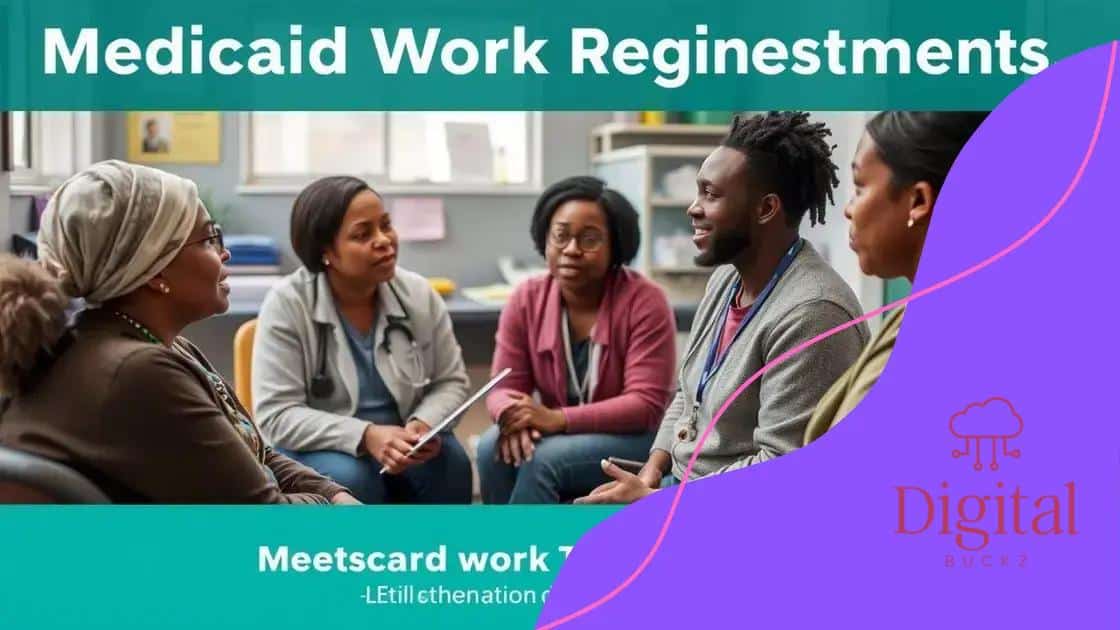Medicaid work requirements 2025: what you need to know

Medicaid work requirements mandate that certain beneficiaries engage in work-related activities to retain their healthcare coverage, impacting access for vulnerable populations and necessitating state support initiatives.
Medicaid work requirements 2025 are creating waves in healthcare policy.
Are you prepared for the changes ahead? Let’s explore what these requirements mean for you and your community.
Understanding Medicaid work requirements
Understanding Medicaid work requirements is essential in navigating healthcare changes.
These requirements aim to encourage employment among participants, helping them achieve financial independence.
As we delve into the implications of these rules, let’s break down the key aspects to grasp what this means for you.
What Are Medicaid Work Requirements?
Medicaid work requirements necessitate that many participants engage in work-related activities
This approach is designed to promote self-sufficiency while ensuring that individuals have access to necessary healthcare benefits.
Who is Affected?
Not everyone on Medicaid will be impacted by work requirements. Generally, individuals who are able-bodied and without dependents must comply. Those who are elderly, disabled, or caregiving for children often have exceptions.
- States have the power to define specific work activities.
- Work can include traditional jobs, volunteering, or job training.
- Compliance with these requirements can affect coverage, making understanding critical.
States manage how these rules are applied. Therefore, the requirements can vary significantly from one place to another.
In addition, beneficiaries must report their hours and activities, maintaining transparency to stay eligible for benefits.
This creates a responsibility to keep track but also opens doors to support services.
Many advocates express concern over the potential loss of coverage for individuals struggling to find work or meet the requirements.
As a result, it’s important to know the resources available, like vocational training programs, which aim to assist those transitioning into the workforce.
The Role of States
Each state designs its own plan for implementing Medicaid work requirements.
Some states have created requirements that demand a minimum number of work hours per week, while others focus on community engagement.
This flexibility allows for unique approaches suited to the specific needs of each population.
Staying Informed
Understanding your state’s specific requirements will help you prepare for potential changes.
Resources like state websites and local health departments can provide updated information on Medicaid and associated requirements.
This knowledge can be a powerful tool in ensuring that you remain eligible for the healthcare services you need.
Eligibility criteria for Medicaid 2025
Eligibility criteria for Medicaid 2025 determine who can access this vital healthcare program. Understanding these criteria is key to ensuring that you or your loved ones can receive the necessary medical assistance.
To qualify for Medicaid, applicants must meet several important requirements.
First, they must be a resident of the state where they are applying. Additionally, income levels play a significant role in determining eligibility.
Income Limits
Each state sets its own income limits, which are often based on the Federal Poverty Level (FPL). The FPL can change annually, impacting how many people qualify for benefits.
Generally, those with incomes below 138% of the FPL are eligible for Medicaid.
- Income is assessed for all household members.
- Different rules may apply for children, pregnant women, and the elderly.
- Some states expand eligibility, allowing more people access.
While income is a major factor, applicants must also consider their household size. Higher household sizes might allow for larger income limits.
This means that a single parent with children might qualify even if their income exceeds individual income limits.
Other Key Factors
In addition to income and residency, several other factors can affect eligibility. Age and disability status are significant as well. For example, people over 65 or those who are disabled may have different eligibility guidelines.
Other relevant criteria include:
- Citizenship or legal residency is required.
- Applicants should not be incarcerated.
- Those who are pregnant may qualify for special programs.
It’s crucial for potential applicants to check with their state’s Medicaid office. They can provide specific information regarding Medicaid 2025 eligibility criteria.
This ensures you have the most accurate and up-to-date details about your qualification status.
How work requirements affect beneficiaries

Understanding how work requirements affect beneficiaries is crucial for navigating the shifts in Medicaid policies.
These requirements are designed to encourage self-sufficiency but can also create challenges for some individuals.
Beneficiaries must engage in specific work-related activities to maintain their Medicaid coverage.
This obligation can take various forms including full-time or part-time employment, volunteering, or participation in job training programs. While these measures aim to boost employment rates, they also place pressure on recipients.
Impact on Healthcare Access
The main concern for many beneficiaries is the potential loss of healthcare access. If individuals fail to meet the work requirements, they risk losing their Medicaid benefits.
This can be particularly troubling for those who face barriers such as childcare responsibilities or health issues.
- Many individuals may struggle to find jobs that fit their needs.
- Some may face difficulties due to lack of transportation or affordable childcare.
- The stress of meeting these requirements can affect mental and physical health.
Another significant factor to consider is the administration and reporting of work hours. Beneficiaries need to regularly report their activities to ensure compliance. This adds another layer of responsibility that can sometimes be confusing.
Support Systems Available
Fortunately, various support systems are in place to assist beneficiaries in meeting these requirements. Many states offer resources like job training programs, educational workshops, and childcare assistance.
These support services can help ease the transition into the workforce and ensure that individuals remain eligible for coverage.
Engaging with local organizations can also provide valuable networks and information on available resources. Talking to caseworkers at local Medicaid offices might reveal additional programs tailored to meet individual needs.
Understanding the implications of work requirements is key to navigating the complexities of Medicaid. Beneficiaries who are aware of their responsibilities and the resources available can better manage their situations and maintain their access to healthcare.
State responses to Medicaid requirements
State responses to Medicaid requirements are varied and reflect local needs and priorities. As states adapt to the changes brought by new legislation, their approaches significantly impact how beneficiaries receive care.
Some states have embraced the work requirements wholeheartedly. They implement strict guidelines, requiring beneficiaries to complete a certain number of work hours each month to maintain their coverage.
These requirements aim to promote employment and self-sufficiency among recipients.
Innovative Approaches
Other states have adopted more flexible approaches. They offer a range of options allowing beneficiaries to meet work requirements through various activities. For instance, volunteering, educational programs, or participating in job training can count towards meeting the criteria.
- States may provide support services, such as childcare, to help individuals succeed.
- Some regions have developed partnerships with local businesses to create job opportunities.
- Others focus on community engagement to enhance participation and compliance.
In addition to implementing work requirements, many states are enhancing their outreach efforts. They aim to inform beneficiaries about the new rules and available resources.
Ensuring that individuals understand their obligations is vital for protecting their Medicaid benefits.
Challenges Faced
States also encounter several challenges while implementing these requirements. For instance, beneficiaries who face barriers to employment, like disabilities or lack of transportation, may struggle to comply.
Addressing these challenges is essential for a successful transition to the new policies.
Some states are responding by offering additional resources, such as job training programs and counseling services. However, the effectiveness of these initiatives often depends on adequate funding and community support.
Understanding the diverse responses from states provides valuable insight into how Medicaid requirements evolve. Staying informed about local policies can help beneficiaries navigate the complexities of maintaining their healthcare coverage.
Future implications of Medicaid work rules

The future implications of Medicaid work rules are significant and multifaceted. As states continue to implement these requirements, the landscape of Medicaid coverage may change dramatically.
Understanding these implications is essential for beneficiaries and policymakers alike.
One major concern is how these rules will affect access to healthcare. Many people may lose their coverage if they cannot meet the work requirements.
This could lead to increased rates of uninsured individuals, which could strain public health systems and drive up healthcare costs for everyone.
Impact on Vulnerable Populations
Vulnerable groups may face difficulties in complying with work rules. Individuals with disabilities, the elderly, and single parents may struggle to find jobs that meet the requirements.
This highlights the necessity for states to create more inclusive policies and support systems.
- Some fear that these rules will disproportionately affect minorities and low-income families.
- Access to training programs and resources is essential to help these groups comply.
- Health outcomes could worsen if individuals lose benefits and therefore healthcare access.
As the future unfolds, states may adapt their approaches. Some might find ways to integrate flexibility into their work rules, such as allowing exemptions for certain groups or alternative pathways to compliance.
This adaptability can ensure that those who truly need healthcare access are not left behind.
Job Market Considerations
The state of the job market will also play a crucial role in the effectiveness of Medicaid work rules. If the economy is strong and jobs are plentiful, individuals may find it easier to meet these requirements.
However, in times of economic hardship, non-compliance due to lack of employment opportunities could spike.
Given these factors, state and federal governments must monitor employment trends closely. They should be ready to adjust Medicaid regulations if job availability decreases or if unforeseen challenges arise.
This proactive approach could help mitigate negative impacts on beneficiaries.
Ultimately, the conversation surrounding Medicaid work rules will continue to evolve. Stakeholders must engage in ongoing dialogue to address the complexities involved, ensuring that healthcare remains accessible to all who need it.
In summary, the future of Medicaid work rules has far-reaching implications for beneficiaries and healthcare systems alike.
While these requirements aim to promote employment and self-sufficiency, it is essential to consider the challenges they pose for vulnerable groups.
States must stay adaptive and responsive to ensure that all individuals maintain access to necessary healthcare. Ongoing dialogue among stakeholders, policymakers, and the community is key to finding the best path forward.
With the right resources and support, we can work together to navigate these changes effectively.
FAQ – Questions about Medicaid Work Requirements
What are Medicaid work requirements?
Medicaid work requirements are rules that require certain beneficiaries to participate in work-related activities to maintain their healthcare coverage.
How do these requirements affect vulnerable populations?
Vulnerable populations, such as the elderly, disabled, or single parents, may find it challenging to meet work requirements, risking their healthcare access.
What kind of support is available for beneficiaries?
Many states offer resources such as job training programs, childcare assistance, and community engagement initiatives to help beneficiaries comply with work rules.
How can beneficiaries stay informed about changes to Medicaid work rules?
Beneficiaries should regularly check with their state’s Medicaid office and local organizations for updates on policies and available support resources.






